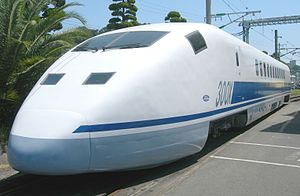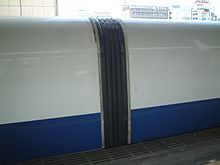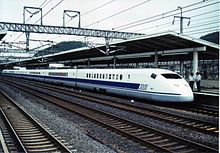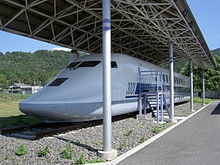- 300X
-
Class 955 "300X" 
Preserved car 955-6 at Hamamatsu Works, July 2010In service 1994–2002 Manufacturer Hitachi, Kawasaki Heavy Industries, Mitsubishi Heavy Industries, Nippon Sharyo Constructed 1994 Scrapped 2002 Number built 6 vehicles Number in service None Number preserved 2 vehicles Number scrapped 4 vehicles Formation 6 cars Fleet numbers A0 Operator JR Central Depot(s) Tokyo Line(s) served Tōkaidō Shinkansen Specifications Car body construction Aluminium alloy Car length 27,150 mm (89 ft 1 in)
(end cars), 25,000 mm (82 ft 0 in)
(intermediate cars)[1]Width 3,100 mm (10 ft 2 in) Height 3,300 mm (10 ft 10 in) Maximum speed 350 km/h (217 mph) (nominal) Traction system 500 kW (670 hp) motors
(4 per car)Power output 12 MW (16,000 hp) Electric system(s) 25 kV AC, 60 Hz Current collection method Overhead catenary Gauge 1,435 mm (4 ft 8 1⁄2 in) "300X" was the name given to the Class 955 (955形) 6-car experimental Shinkansen train developed in 1994 by the Central Japan Railway Company (JR Central) in Japan to test technology to be incorporated in future shinkansen trains operating at speeds of 300 km/h (186 mph) or higher.[2]
Contents
Design
Manufacture of the train was shared among four different manufacturers, with a number of different body construction methods used. The two ends cars employed differing nose designs, and a number of pantograph shroud designs were tested over the lifetime of the trainset.[2]
Formation
Car No. 1 2 3 4 5 6 Designation Mc M M M M Mc Numbering 955-1 955-2 955-3 955-4 955-5 955-6 Weight (t) 36 36 36 32 36 36 Cars 2 and 5 were fitted with pantographs.[3]
955-1
End car with "cusp" nose design, built by Mitsubishi Heavy Industries. The body was constructed of rivetted Duralumin. This car had no passenger seats.[2][1]
955-2
The body was constructed by Nippon Sharyo using large hollow aluminium extrusions. This was the only car in the trainset to be fitted with passenger seats.[2]
955-3
This vehicle was constructed by Kawasaki Heavy Industries using spot-welded large aluminium extrusions, and was fitted with active tilting.[2]
955-4
This vehicle was constructed by Nippon Sharyo using large hollow aluminium extrusions, similar to car 2, and was equipped with large side doors for installing and removing test equipment.[1]
955-5
This vehicle was constructed by Hitachi using aluminium honeycomb panels. This car had no seats.[2][1]
955-6
Hitachi-built end car with "wedge" nose design. The body was constructed of brazed aluminium honeycomb panels.[1]
History
The train was unveiled on 22 December 1994[4]
Test-running on the Tōkaidō Shinkansen was delayed by track damage caused by the Great Hanshin earthquake in January 1995, but full-scale test-running commenced on 25 May 1995, between Maibara and Kyoto.[4]
On 21 September 1995, the Class 955 train recorded a maximum speed of 354.1 km/h (220.0 mph) on the Tōkaidō Shinkansen between Maibara and Kyoto.[5]
On 11 July 1996, the train recorded a maximum speed of 426.6 km/h (265.1 mph), exceeding the previous national speed record of 425.0 km/h (264.1 mph) set in December 1993 by JR East's Class 952/953 "STAR21" experimental train.[5]
On 26 July 1996, the train recorded a Japanese national speed record of 443.0 km/h (275.3 mph) on the Tōkaidō Shinkansen between Maibara and Kyoto.[3] This record still stands as of May 2011.
The Class 955 trainset was officially withdrawn on 1 February 2001.[6]
Preservation
End car 955-1 is preserved outdoors at the RTRI large-scale wind tunnel test facility in Maibara, Shiga.[7] End car 955-6 was initially preserved inside JR Central's Hamamatsu Works, and was moved to the new SCMaglev and Railway Park in 2010.[8]
See also
 Media related to Class 955 "300X" at Wikimedia Commons
Media related to Class 955 "300X" at Wikimedia CommonsReferences
- ^ a b c d e JR全車輛ハンドブック2001 [JR Rolling Stock Handbook 2001]. Japan: Neko Publishing. 2001. ISBN 4-87366-723-2.
- ^ a b c d e f プロトタイプの世界 - Prototype World. Japan: Kōtsū Shimbunsha. December 2005. p. 60–63. ISBN 4910065141258.
- ^ a b JR電車編成表 '98夏号 [JR EMU Formations - Summer 1998]. Japan: JRR. July 1998. ISBN 4-88283-029-9.
- ^ a b Suda, Hiroshi (2000). 東海道新幹線 [Tōkaidō Shinkansen]. Tokyo, Japan: JTB Can Books. ISBN 4-533-03563-9.
- ^ a b Semmens, Peter (1997). High Speed in Japan: Shinkansen - The World's Busiest High-speed Railway. Sheffield, UK: Platform 5 Publishing. ISBN 1-872524-88-5.
- ^ 新幹線電車データブック2011 [Shinkansen Databook 2011]. Japan: JRR. March 2011. p. 95. ISBN 978-4-330-19811-8.
- ^ 鉄道のテクノロジーVol1:新幹線 [Railway Technology Vol.1: Shinkansen]. Japan: Sanei Mook. April 2009. p. 122. ISBN 978-4-7796-0534-5.
- ^ "JR東海博物館(仮称)建物内への展示車両の搬入について [Installation of exhibits in JR Central Museum]" (in Japanese) (pdf). JR Central. 21 July 2010. http://jr-central.co.jp/news/release/_pdf/000008626.pdf. Retrieved 10 March 2011.
Shinkansen Lines in service Main lines Mini-Shinkansen
Future lines Cancelled lines Service names In service Discontinued Aoba • AsahiTrainsets In service 100 Series • 200 Series • 300 Series • 500 Series • 700 Series • N700 Series • 800 Series • E1 Series • E2 Series • E3 Series • E4 Series • E5 SeriesOn order E6 Series • L0 seriesRetired Export trainsets Non-revenue
earning trainsetsClass 1000 • Class 951 • Class 961 • Class 962 • Doctor Yellow • WIN350 • STAR21 • 300X • Fastech 360 • Gauge Change Train • MLX-01Operators Experimental and Prototype High-speed trains France France & Germany EurotrainGermany Japan JR–Maglev · Class 1000 Shinkansen · Class 951 Shinkansen · Class 961 Shinkansen · Class 962 Shinkansen · WIN350 · STAR21 · 300X · Fastech 360Korea Russia / USSR United Kingdom USA / Canada See also Category:Experimental and prototype high-speed trains , High-speed rail , List of high speed trainsCategories:- Experimental and prototype high-speed trains
- Shinkansen train series
- 1994 introductions
- Tilting trains
- Hitachi multiple units
- Kawasaki rolling stock
- Nippon Sharyo rolling stock
Wikimedia Foundation. 2010.



